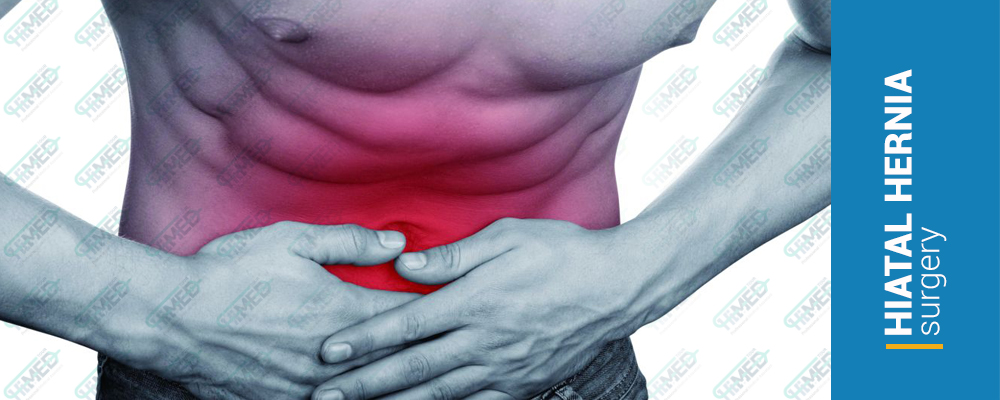
Hiatal Hernia Surgery
4min ReadBefore you read about hiatal hernia surgery, you must understand what a hiatal hernia is. Your stomach is normally below the diaphragm, a thin muscle that separates your chest from your abdomen. The esophagus, which brings food from your mouth to your stomach, passes through a hole in the diaphragm called the esophageal hiatus before reaching the stomach. A hiatal hernia is when the top part of your stomach slips through the hole in the diaphragm and into your chest cavity.
Types of hiatal hernia:
- Sliding hernia: A sliding hernia is when the top part of the stomach and the end of the esophagus slide through the esophageal hiatus. 95% of hiatal hernias are of this type. This type of hernia normally does not cause any symptoms. If the hernia is big, acid may return from the stomach to the esophagus due to high pressure which causes GERD (heartburn). People with heartburn experience a burning sensation in the chest and throat, stomach or chest pain, hoarseness, difficulty swallowing, and coughing for no reason. Serious side effects are very rare.
- Rolling hiatal hernia: In this type, only the top part of the stomach slides through and not the esophagus. It is not very common and is usually a side effect of stomach or esophagus surgeries. Most people who have this type don’t experience any symptoms. However, some do and the symptoms they experience include pain above the stomach and feeling full and nauseated after eating. Serious, fatal side effects may include ulcers and bleeding in the stomach and shortness of breath due to pressure on the lungs.
The doctor will prescribe only medication and lifestyle changes as long as the symptoms are not serious. If the drugs are not enough and the symptoms become worse, your doctor will recommend surgery. There are different methods to treat the hernia, your doctor will choose the right one based on your conditions. The most popular method is nissens’s fundoplication, which will be explained below.
Treatment duration
This procedure normally takes around 1-2 hours.
Paraclinical testing
CT scanning, endoscopy, barium swallowing, and a simple abdomen x-ray will be used to determine the type and severity of the hernia. Routine blood and urine tests are also mandatory before the surgery.
Preoperative care, the procedure, and postoperative care
Before the surgery
The doctor will decide whether the surgery is necessary or not. Trust them in this regard. Provide a list of all the medications, supplements, and herbal medicines that you are using to the doctor. Tell your doctor about your medical history and your allergies, especially allergies to anesthetics. Consult your doctor about taking aspirin and other blood thinners. Start fasting the midnight before the surgery.
The hiatal hernia surgery
This procedure requires general anesthesia. It can be done in two ways: open surgery or “minimally invasive” surgery which is known as laparoscopy. If you will be undergoing an open surgery, a long incision will be made on your abdomen. Otherwise, 5-6 small incisions will be made at different points through which a camera and the surgical instruments will be inserted. The main goal is to put the stomach and esophagus back in their place and then tighten the hole (hiatus) so that they don’t slip back. The surgeon does this by wrapping the top part of the stomach around the esophagus.
After the surgery
The surgical wound will be painful for the first week. You can use the prescribed painkillers to alleviate this pain. Consume only liquids after the surgery but slowly incorporate soft foods such as mashed potatoes and soup into your diet. You can shower after 5 days but you must cover the wound with waterproof bandages. Avoid foods that can cause bloating. Do not drive for at least 10 days. Avoid lifting heavy objects for at least 1 month.
Important notes regarding hiatal hernia surgery
When should I have a hiatal hernia surgery?
- When the symptoms become severe and affect your day-to-day life.
- If the symptoms don’t respond to medication.
- When there’s a chance that the stomach might become “strangled” and lose its blood-flow. This could cause the stomach tissue to die and can be fatal.
- If bleeding or ulcers occur or the esophagus tightens.
Duration of hospitalization
The duration of hospitalization varies depending on whether you had an open surgery or laparoscopy. The patient is normally hospitalized for 1-2 days.






Reviews
Number of pending reviews175